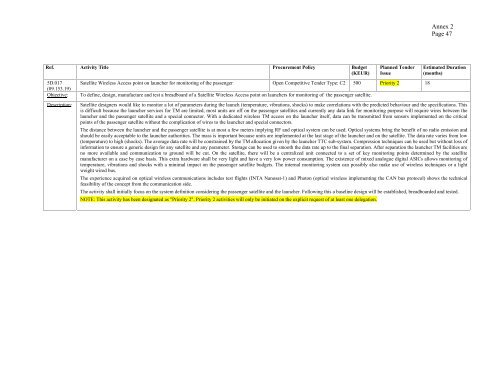ARTES-5.1 â ESA Telecom Technology Workplan ... - Emits - ESA
ARTES-5.1 â ESA Telecom Technology Workplan ... - Emits - ESA
ARTES-5.1 â ESA Telecom Technology Workplan ... - Emits - ESA
- No tags were found...
Create successful ePaper yourself
Turn your PDF publications into a flip-book with our unique Google optimized e-Paper software.
Annex 2Page 47Ref. Activity Title Procurement Policy Budget(KEUR)5D.017(09.153.19)Objective:Description:Planned TenderIssueSatellite Wireless Access point on launcher for monitoring of the passenger Open Competitive Tender Type: C2 500 Priority 2 18To define, design, manufacture and test a breadboard of a Satellite Wireless Access point on launchers for monitoring of the passenger satellite.Estimated Duration(months)Satellite designers would like to monitor a lot of parameters during the launch (temperature, vibrations, shocks) to make correlations with the predicted behaviour and the specifications. Thisis difficult because the launcher services for TM are limited, most units are off on the passenger satellites and currently any data link for monitoring purpose will require wires between thelauncher and the passenger satellite and a special connector. With a dedicated wireless TM access on the launcher itself, data can be transmitted from sensors implemented on the criticalpoints of the passenger satellite without the complication of wires to the launcher and special connectors.The distance between the launcher and the passenger satellite is at most a few meters implying RF and optical system can be used. Optical systems bring the benefit of no radio emission andshould be easily acceptable to the launcher authorities. The mass is important because units are implemented at the last stage of the launcher and on the satellite. The data rate varies from low(temperature) to high (shocks). The average data rate will be constrained by the TM allocation given by the launcher TTC sub-system. Compression techniques can be used but without loss ofinformation to ensure a generic design for any satellite and any parameter. Storage can be used to smooth the data rate up to the final separation. After separation the launcher TM facilities areno more available and communication to ground will be cut. On the satellite, there will be a centralized unit connected to a set of key monitoring points determined by the satellitemanufacturer on a case by case basis. This extra hardware shall be very light and have a very low power consumption. The existence of mixed analogue digital ASICs allows monitoring oftemperature, vibrations and shocks with a minimal impact on the passenger satellite budgets. The internal monitoring system can possibly also make use of wireless techniques or a lightweight wired bus.The experience acquired on optical wireless communications includes test flights (INTA Nanosat-1) and Photon (optical wireless implementing the CAN bus protocol) shows the technicalfeasibility of the concept from the communication side.The activity shall initially focus on the system definition considering the passenger satellite and the launcher. Following this a baseline design will be established, breadboarded and tested.NOTE: This activity has been designated as "Priority 2". Priority 2 activities will only be initiated on the explicit request of at least one delegation.
















